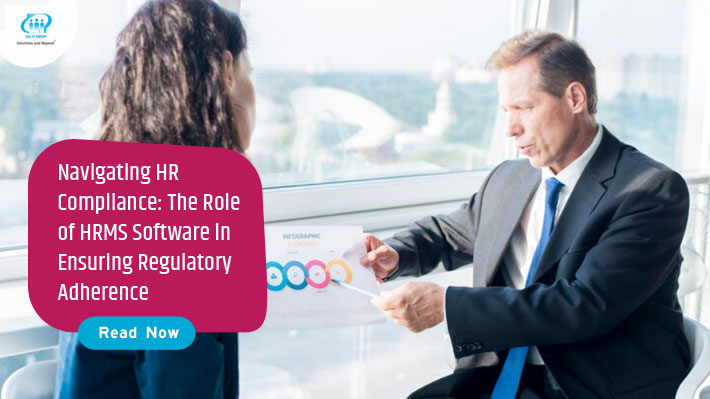Discover how HRMS software aids in ensuring compliance with labour laws and regulations, safeguarding against penalties and legal challenges. Find insights on selecting the right HRMS solution and leveraging reporting and analytics for proactive compliance management.
Labour laws and regulations have become an important part of the constantly changing business environment, and this is a critical area of human resource management. Not following these rules can lead to very tough consequences, among them being slapped with hefty fines, complicated legal challenges and ruining the company’s reputation.
However, HRMS (Human Resource Management System) software is a very handy tool that organisations can use to avoid any hurdles during the operations and remain compliant with the regulations.
Understanding HR Compliance
HR compliance is a combination of legal and policy measures that are binding to the entities. These include:
- Fair labour practices
- Employee rights and benefits
- Workplace health and safety laws
- Equal Employment Opportunity (EEO) laws
- Privacy and protection of data laws
Trying to pass through the complicated mesh of these regulations can be an overwhelming job, particularly for companies working in different fields or across multiple localities.
The Function of HRMS Software:
Centralised Data Management
One of the fundamental benefits of cloud-based HRMS in Dubai system is its ability to centralise and order employee data, thereby ensuring correct record-keeping and easy access to information. Thus, the streamlined data management process reduces the chance of non-compliance because of the missing or misplaced documents or due to inaccurately stored documents, respectively.
Automated Compliance Tracking
It is one of the most common features of the HRMS software which automates the compliance-related tasks and deadlines tracking. This includes:
- Monitoring staff training and credentials
- Managing employees leave and attendance
- Keeping handbooks and policies updated
- Creating the compliance reports and audits
Automated procedures by HRMS software are the proof of the measures, which will help to avoid human mistakes and always guarantee the regulations will be followed.
Payroll and Benefits Administration
These payroll and benefits administration are the key aspects where compliance is absolutely important. The HRMS software connects to payroll software to ensure the calculated and distributed employee salaries, taxes, and benefits are correct. This effectively safeguards the enterprise against the occurrence of labour law non-compliance or tax regulation violations.
Policy Management and Communication
In the workplace, proper policy implementation and communication are the key factors of building a compliant culture. HRMS application provides an integrated system where the company’s policy, handbook, and training documents are kept and distributed. This way, employees are always able to get the latest information and the risk of non-compliance due to lack of awareness is minimized.
Software Update Regularity: A Key Factor
Regulatory adjustments that involve, for example, labour law alterations or the introduction of new data privacy regulations may have a huge impact on HR compliance requirements. HRMS software suppliers play the key role in making sure their solutions are up to date by supplying regular patches and software updates.
Companies should first of all, partner with vendors that offer a historic record of delivery and regular communication about regulatory changes and software updates. It not only keeps the HRMS software features compliant but also significantly reduces the risk of non-compliant features due to outdated features.
Selecting the Correct HRMS Software:
When selecting an HRMS software solution, it is essential to consider the following factors:
- Compliance tracking and reporting functionality
- Integration with payroll software and other HR systems
- Sustainability to cater to the business expansion
- User-friendliness and simplicity of implementation
- Vendor assistance and software updates to ensure regulatory compliance
Through a comprehensive assessment of these factors, an organization can identify the HRMS software that is in line with their specific compliance requirements and will make an easy switch to the HRMS system that is more compliant and effective.
Compliance Reporting and Analytics
The strong reporting and analytics functions are the most important to help organizations determine how their compliance efforts are going. HRMS software usually contains reports that are included as a built-in feature and these reports serve to draw attention to compliance issues and non-compliance risks in specific areas.
These reports can be adapted to meet different organizational needs and statutory requirements, hence, revealing areas like employee turnover, leave management, and payroll errors. The existence of such reports allows the organizations to take a proactive approach to the identification and resolution of these compliance issues before they climax.
HRMS Software as a Tool for Continuous Improvement
Compliance is an ongoing process that should not be considered final but instead, should be monitored and improved. Human resources management software can be a very significant tool in this process because it is a means for creating a centralized system where compliance metrics are tracked and analyzed over time.
Using the data and the insights gained from the HRMS software, organizations can spot areas for improvement, build strategies to increase compliance processes and track the effectiveness of the implemented changes. This way helps to keep the compliance efforts up-to-date and consequentially relevant and effective, with the regulatory requirements progressing.
In Conclusion
The implementation of HRMS will probably continue to rise as organizations put more focus on compliance and the optimization of their HR processes. The adoption of this technology, on the other hand, is not only about the fulfillment of the regulations but also the ability to unleash the potential for increased productivity and efficiency while at the same time boosting the organization’s success.
